The only one positive consequence of the 1986 Chernobyl disaster is that the accident served as a powerful boost in the development of USSR robotics technology. By the time of the accident, it turned out that the country had been the first to launch a man into space, which had a powerful scientific base for the development of automatic devices for conquering the Moon and Mars, but there were still no robots capable of helping a person in emergencies on earth.
Robots – able to enter a burning building or inspect areas with a high radiation background were not developed or produced during those times. The Chernobyl accident revealed this problem. It became clear that it was critical in the shortest time to develop robotic equipment that would be able to work in extreme conditions.
Robot’s Help in the Chernobyl Disaster
It turned out that part of the work in cleaning (decontaminating) the buildings of the Chernobyl Nuclear Power Plant simply could not have been done without automatic, remotely controlled systems – the levels of radiation excluded the presence of a person.
A catastrophe of this magnitude happened for the first time, that’s why the optimal design of robots was unknown. Scientists experimented, optimizing models for specific tasks. The batteries ran out quickly and radio communications did not work well due to the ionization that radioactive radiation creates.
After the Chernobyl catastrophe, a full-scale development and subsequent production of robots began. Different robots were created for the needs of the liquidation of the accident – depending on the type of task. The main tasks for robots in 1986 were:
- to conduct radiation reconnaissance;
- dismantle the debris of the destroyed reactor;
- television and photography;
- sampling of radiological materials;
- burial of radioactive materials.
with such working conditions like – open space, corridors and communications in the Shelter object etc. …
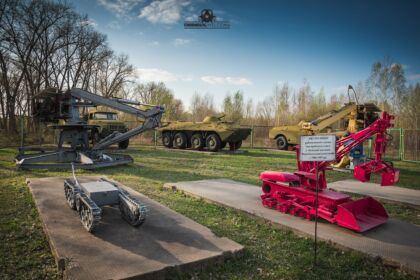
Chernobyl Open Air Museum of Machinery in Chernobyl town.
Photo: Zdeněk Mlnařík
Such work was carried out both on the roof of the Chernobyl Nuclear Power Plant and in the territories adjacent to the destroyed block, where mainly robots were involved in the decontamination and disposal of radioactive materials. Also, robots were required after the epoch-making construction of a Shelter over the destroyed reactor.
The Chernobyl robot had to be able to work in conditions of high levels of radiation fields, had to have the ability to move on difficult surfaces (with the presence of blockages and obstacles), and also had to be subject to inspection, repair and decontamination of the robot’s equipment and systems. About 15 types of modular robots were involved in the elimination of the accident, which had different purposes. Light robots – scout robots were used to study the radiation situation in the premises of the Sarcophagus, heavy robots – technological robots intended for cleaning (decontamination) of the territory.
Who constructed the Chernobyl Robots?
A large number of scientists, institutes, and design bureaus were engaged in the design and testing of robots for Chernobyl. Teams of many institutes united to create robotic complexes. In real conditions of the Sarcophagus, both domestic and foreign robots (made in Germany, Japan, USA) were tested.
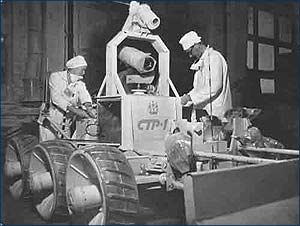
After the Chernobyl accident, competition arose among the design bureaus: everyone suddenly realized that those who successfully cope with the liquidation task would receive funds for the development of this area and powerful state support. Therefore, other organizations wanted to participate. To create the Chernobyl robots-liquidators, more than 40 industrial enterprises were connected to the project.
The main robotic center of the USSR, the Leningrad Central Research Institute of Robotics and Technical Cybernetics (now Russian State Scientific Center for Robotics and Technical Cybernetics) was involved in the work. Within two months, the Central Research Institute of RTC had developed, manufactured and sent 15 robots for various purposes to the station.
The list of the main institutes involved in the development of robots and robotic systems for the Chernobyl Nuclear Power Plant in 1986 were:
- Mobile Vehicle Engineering Institute;
- VNIIAES;
- RKK “Energiya”;
- Kyiv Institute of Automatics;
- Bauman Moscow State Technical University;
- Leningrad Central Research Institute of Robotics and Technical Cybernetics;
Documentary video – a robot on the roof of the Chernobyl Nuclear Power Plant in 1986.
Problems of Robotic Science and Robots
The accumulated knowledge on the use of robots to eliminate the Chernobyl accident had allowed us to understand and identify the problems facing extreme robotics. In particular, robot designers had come to the conclusion that for robots that are used in extreme situations, it is necessary to improve the quality of power systems.
The robots were designed both at the stage of the acute phase of the accident (the first months after the accident) and in “peacetime”. In this regard, several stages can be distinguished in the development of Chernobyl robotics – the stage of using robots in the acute period of liquidation of the accident, the stage of development of robotics for reconnaissance and study of the Sarcophagus, and the stage of designing robots to turn the Sarcophagus into an environmentally friendly system (in fact, these systems had to be dismantled and they had to bury the Sarcophagus and radioactive materials). Although the stages are highlighted conditionally, they reflect a general trend towards changing requirements for robots developed and used for Chernobyl.

Chernobyl robots then and now.
Source: Reddit
In fact, this is the main problem of modern robotics, requiring the development of new physical approaches to solve the problems of controlled movement (new ways of moving robots) and new approaches to provide the robot with electricity.
The remote control was an important problem in the use of robots at the Chernobyl NPP. This problem required the development of reliable remote and telecontrol methods. It was also necessary to improve the intellectual capabilities of autonomous robot control systems, which is directly related to the development of artificial intelligence.
“The use of robots was not successful because all the robots that were tested initially were either mechanically unable to operate among the wreckage, or they simply could not overcome the obstacles on large irregular surfaces. When on an even surface but inside strong radiation fields, their electronics, usually the control modules, failed making them inoperable*. That’s why in the end, the most reliable method was to use radio-controlled bulldozers or just simple scraper bulldozers, our ordinary vehicles, cabins of which were reliably covered with lead to protect the driver. During the first stages, this was the most effective way where by using ordinary vehicles but with proper crew protection, it became possible to collect and dispose of the most contaminated debris, the most dangerous contaminations”, – Valeryi Legasov.
On the roof of the Chernobyl NPP. Robots “Fedya”, “Joker” and stools on wheels.
Not all robots that tried to be involved in the elimination of the accident were able to complete the assigned tasks and carry out the necessary work. Most of the robots turned out to be unsuitable for work in the conditions of the Chernobyl Nuclear Power Plant. For example, the radio-controlled amphibious bulldozer “KOMATSU”, which had even been able to work on the seabed, could not withstand the radiation loads and quickly went out of order. According to existing information, the brand of the bulldozer is “Komatsu D-355W”. Two German robots MF-2 MF-3 were also unsuitable for work in such harsh radiation conditions.
“… as I have already said, the robotic devices we had, be it our own or acquired from abroad, turned out to be practically useless in those conditions. Say, even if a robot had sufficiently reliable electronics, it could not overcome obstacles, that were the result of a large amount of wreckage of the 4th block, and stopped. This was the reason they were unusable. If, however, the researchers received robots that had good all-terrain travel capability in the most difficult conditions, then their electronics would fail because of the high gamma radiation and they also stopped,” – from Valery Legasov’s tapes.
Robots
Mobot- Ч-ХВ2
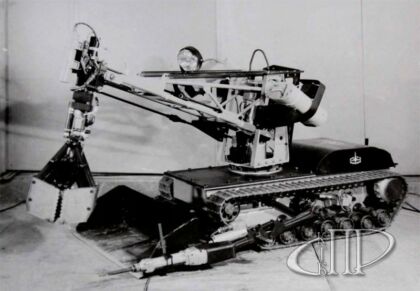
Mobot- Ч-ХВ2
Source: Industrial Culture Museum
The mobot is the first prototype of the robot, which was designed by the Bauman Moscow State Technical University at the department, which today has the name “Multipurpose tracked vehicles and mobile robots” specifically to eliminate the Chernobyl accident.

Mobot- Ч-ХВ2 in Chernobyl museum of robotic equipment.
Photo: CHERNOBYLwel.come
The abbreviation of the name means the following: the word Mobot is a mobile robot, the letter “Ч” means Chernobyl, and “XB” means chemical troops.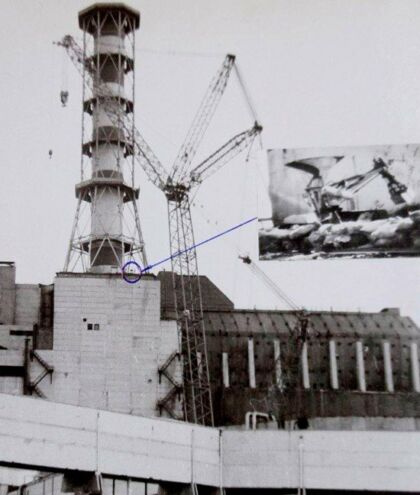
Mobot- Ч-ХВ2 on the roof of the Chernobyl NPP
Source: Industrial Culture Museum
The main characteristics of the Mobot- Ч-ХВ2 were:
- total weight – 430 kg;
- equipped with a tracked chassis;
- equipped with a cable-power supply (cable length 200 meters).
The robot had working equipment for cleaning the roof of the Chernobyl nuclear power plant, as well as equipment for conducting radiation reconnaissance.
STR-1

STR-1 robot on the roof of the Chernobyl NPP, nicknamed “Moon walker” for resemblance with Soviet moon rover.
Photo: VNII “Transmash”
The specialized transport robot (STR-1) is a legendary and well-known (according to the footage of the chronicles of the liquidation of the accident) apparatus that took an active part in cleaning the roof of the Chernobyl NPP from the debris of highly radioactive elements of the destroyed reactor. The robot was operated at gamma-background levels of up to 3000 Roentgens per hour, in some parts up to 10,000 roentgens per hour.
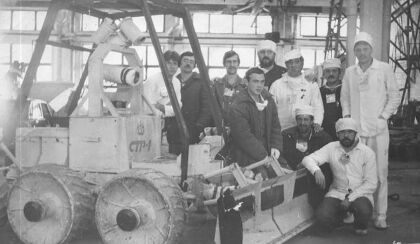
Robot STR-1 and liquidators
Source: zik.ua
Robot Specifications:
- The total weight – 1100 kilograms,
- Travel speed – up to 1 km / h,
- Battery power supply – two silver-zinc batteries.
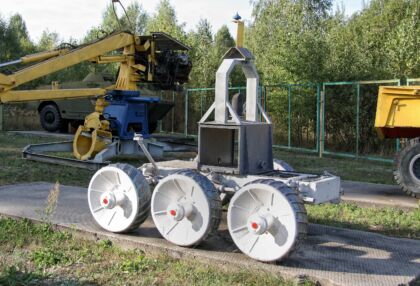
STR-1 in Chernobyl museum of robotic equipment.
Photo: CHERNOBYLX
These are the remains of the STR-1 robot in the open area of the liquidators’ equipment in Chernobyl. According to some reports, the use of this machine allowed the health of almost 1000 people to be preserved. It was exactly how many soldiers it would take to do all its work.
For the first time, the robot was launched on the roof of the Chernobyl Nuclear Power Plant at the end of August 1986.
US Robot Pioneer

US Robot Pioneer
Source: Pioneer Robotics
By the end of the nineties, the scale of the man-made disaster had grown to world levels, so foreign partners joined the Russian and Ukrainian specialists. To eliminate the consequences of the Chernobyl accident, the US Department of Energy and NASA created a multifunctional Pioneer robot worth $ 3 million. The robot consisted of the following components:
- self-propelled cart;
- power management and distribution system;
- remote observation system with 3D-mapping;
- environmental monitoring system;
- manipulator;
- drilling device.
Thanks to a 400-meter cable, equipped with hermetically sealed blocks, the robot could be controlled from a safe distance. The robot could assess the condition of the Shelter’s structures and was also able to cut and deliver samples of walls and floors.
Although the Pioneer was transferred to Ukraine in 1998, it was not used at the Chernobyl Nuclear Power Plant and is still in the Slavutych training center.
KOMATSU D155W
Komatsu was the first in the world to commercialize an amphibious bulldozer, the D155W, capable of underwater operations at a maximum depth of 7 m (23 ft) and onshore operations via a remote control.

Komatsu D155W in the Chernobyl Exclusion Zone
Source: Reddit
It was a robot-bulldozer developed by a Japanese company, used to investigate the radiation situation. It was a radio-controlled bulldozer – an amphibian that could even work under water, unfortunately from the received doses of radiation, it quickly lost its ability to work.

Komatsu D155W nowadays in the Chernobyl Exclusion Zone.
Photo: Stas & Vika Polessky
The remains of this bulldozer are still on the territory of the Jupiter factory in Pripyat.
What happened to Joker the robot?

MF-2 aka the “Joker” being unloaded.
Source
The yellow Chernobyl robot (robot Joker) has been brought to the forefront of people’s minds since HBO aired the five-part miniseries about the Chernobyl disaster. The Joker was one of the latter robots, which was originally from West Germany, and was sent to the rooftop to remove the highly radioactive rubble.

MF-2 robot being adjusted.
Source: Reddit
Two men risked their lives moving graphite to make sure the Joker could move freely on the roof.
There is a myth relating to the famous “Joker” robot (actual name MF-2, MF-3 was also there), where it is said that it became inoperable because “bureaucrats” had lowered radiation requirements when ordering it. This is only a myth, because the robot was built in 1974 and was working in laboratories.

The MF-3 robot, ordered from Germany.
Source: Reddit
Later in 1982 it had undergone modernization and was sent to Chernobyl in 1986. The reason it had failed was because it had control circuits on its bottom, but the roof surface of the 3rd block was covered with graphite particles which had melted inside it, so most of the radiation was from underneath the machine where it was most vulnerable.
“The Soviets — and this is mind-blowing to me — they refused to tell anyone how bad the situation was. Even then, months later, after the world knew about Chernobyl and knew what it meant they were still soft-pedaling just how bad it was to the point where they refused to tell the West Germans how much radiation was on that roof. It was 600 percent or 700 percent more than it could handle. And what blows my mind is the Soviet power system thought that was OK. Why not? Let’s just see. It’s the same kind of attitude that leads to Chernobyl in the first place,” series co-creator Craig Mazin said on the show’s companion the Chernobyl Podcast.

Chernobyl Robot Joker. Burikivka Vehicle Graveyard.
Source: Reddit
The Joker is still in the area of Chernobyl Zone and can be found in a pile of discarded items in the radiation zone – the Burikivka Vehicle Graveyard. The robot itself is still very dangerous and highly radioactive.
With the Joker and other robots having failed, the Soviet Union ultimately turned to “biorobots” (humans) as they were referred to by officials.

Сleaning-up on the roof of Chernobyl NPP
Photo: Igor Kostin, SYGMA/CORBIS
Groups of soldiers were sent onto the roof to clear the dangerous debris, and the radiation exposure was so high that they could only remain up there for 90 seconds at a time. Roughly 3,000 men took part in this mission, all equipped with homemade armor.
Experts note that the accumulated experience of using robots to eliminate the Chernobyl accident has contributed to the emergence of a new direction in robotics, which is called “extreme robotics”. Today, “extreme robotics” covers a number of important areas of human activity – robots are used to eliminate natural and man-made emergencies. The robots that study difficult and dangerous areas, are used for rescue operations, to perform complex technological operations, and are also used for work underwater.
P.S. In our next blogs we’ll throw light on the “biorobots”. Stay tuned for our updates!
If you’re eager about the Chernobyl robots, you can already arrange your visit in the Chernobyl Exclusion Zone or Pripyat today and see it all with your own eyes.



 ChernobylX
ChernobylX
 ChernobylX
ChernobylX